The Paris Air Show
Gliders will be the freight trains of the air.
We can visualise a locomotive plane leaving LaGuardia Field towing a train of six gliders in the very near future.
By having the load thus divided it would be practical to unhitch the glider
that must come down in Philadelphia as the train flies over that place - similarly unhitching the loaded gliders
for Washington, for Richmond, for Charleston, for Jacksonville, for Miami.
During that process it has not had to make any intermediate landings, so that it has not had to slow down.
- Grover Loening, 1944
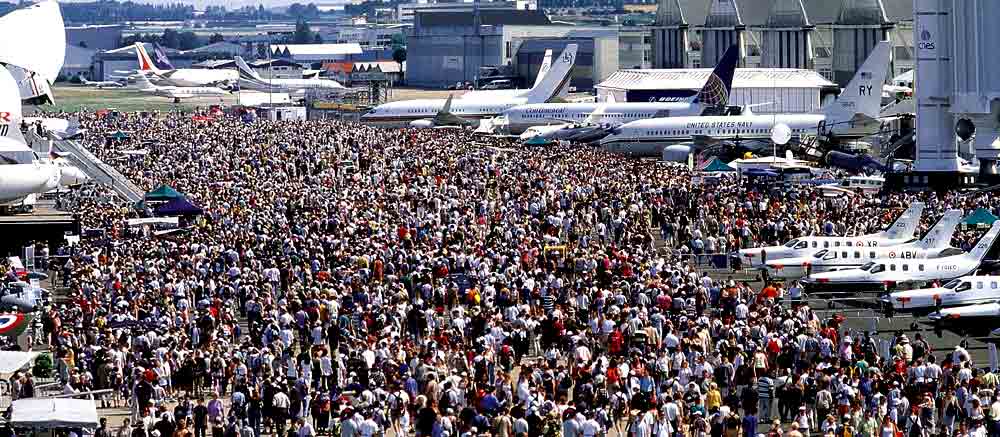
Paris Air Show Bourget - 2005 Source: www.paris-air-show.com

The Show Will Go On
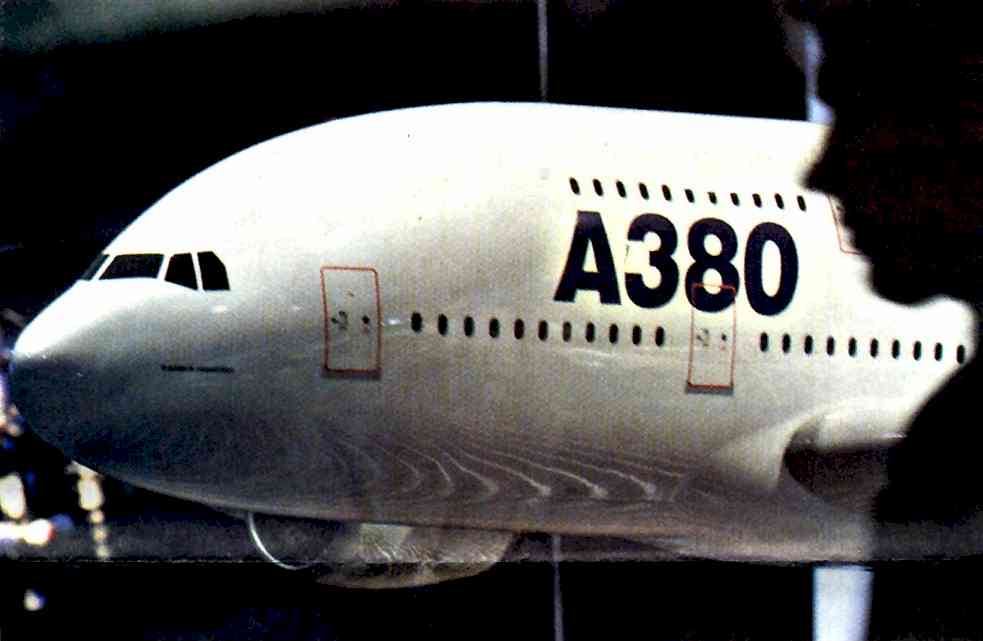
Big Bird: A visitor to the Paris Air Show examines Airbus' A-380 super-jumbo jet model at Le Bourget airport outside Paris.
by Michelle Ciarrocca
As a sign of the Bush administration's displeasure with France because of its opposition to the US-led war in Iraq, the Pentagon is scaling back its presence at this year's Paris Air
Show, the global defense industry's largest and oldest international showcase. But make no mistake, the show will go on. No high-ranking US government officials or general
military officers will be in attendance, and only six military aircraft - all of them being flown in from Operation Iraqi Freedom - will be on display, compared to the dozen or more
usually on exhibit. And there will be no high-profile flight demonstrations of US military aircraft.
Still, officials at the show say that over 1800 companies will be on hand, similar to the record levels of companies exhibiting in 2001. However, this time around, on the heels
of Gulf War II, analysts are predicting a more somber tone than in the wake of past wars.
In June of 1991 the Paris Air Show was a celebration of sorts. US defense contractors displaying the weapons of war stood side by side with the military personnel who had put
them to use just a few months earlier in Desert Storm. While troops told stories of flying, gunning, and driving the Iraqis out of Kuwait, company representatives were busy handing
out posters, coffee mugs, tote bags, pins and other souvenirs adorned with their corporate logos to potential buyers. The 1991 show had the usual displays and exhibitions by the
nation's top weapons makers. But, for the first time the US Air Force, Army and Navy also had booths at the show. More than 150 US military personnel were in attendance,
along with military aircraft there was an added bonus for the industry: US taxpayers picked up the tab.
Representative Pete Stark (Democrat - California), who in the past has introduced legislation to end the use of taxpayer money for the shows, has found that the displays of US
aircraft and personnel at international weapons exhibits like the Paris Air Show cost US taxpayers approximately $35 million a year. Prior to 1991, the federal government's
approach to air shows had been to avoid direct military involvement. Organising and promotional activities were handled by the Department of Commerce, which runs the US-built
pavilion at Le Bourget. Aircraft that were used for static displays on the tarmac or demonstration flights over the show were leased to US companies by the Department of Defense,
and taxpayer subsidies were kept to a minimum.
Beyond the issue of whether US tax dollars should be used to subsidise the cost for the shows, a more fundamental question is whether uniformed US military personnel should be used as
virtual sales representatives for private weapons manufacturers. According to military analyst William D Hartung, in 1991, public affairs officer Lieutenant Colonel John Kirkwood
said that then Secretary of Defense Dick Cheney "felt it was appropriate" for the military services to participate in the show to further the favourable image of US soldiers, weapons,
and foreign policy in the aftermath of the first Gulf War.
Clearly, this time around the Bush administration is sending a different message. According to Pentagon spokesman Lieutenant Colonel Michael Humm, Secretary of Defense Donald
Rumsfeld has decided that "in light of the press of other events and the pace of Department of Defense activities... US participation will be more limited than in previous
years." While the Pentagon wouldn't come right out and say that this is payback to the French for not being part of the coalition of the willing, some members of Congress have been
more forthcoming. The most vocal opposition to US participation in the Paris Air Show has come from Representative Jim Saxton (Republican - New Jersey). Saxton introduced a
resolution calling for an outright boycott of the Paris Air Show, saying, "The United States was there for France in the 20th century; we expect France to be there for the United States
in the 21st." The Pentagon's decision to scale back their participation was seen as a compromise designed to placate domestic critics like Saxton while still allowing US arms
makers to hawk their wares at Paris, the world's premiere arms bazaar.
US defense contractors have a different view. They have argued that opting out of the show is a pretty expensive way to deliver a message to the French government. The
Paris Air Show is regarded by the aerospace and defense industries as the networking event of the year. "It's a wonderful time to see customers and competitors," said James Fetig,
a spokesman from defense contractor Raytheon. All of the top US weapons makers will be in attendance, and although their displays may not be as extravagant as previous years, most
company officials cite economic hardship as being the determining factor, not any intention to "send a message" to the French government or anyone else. As Vice Chairman Michael
Sears of Boeing put it, "These events have been getting more expensive, and with the US government cutting back its participation, this seemed like a good time for us to scale back
too."
The 1991 Gulf War - in which many of the major participants in the anti-Iraq coalition faced their own weapons which had been supplied to Saddam Hussein's forces prior to the
conflict - resulted in an outpouring of government promises to bring the arms trade under stricter international controls. We still don't know whether Saddam Hussein posed an
imminent threat prior to Gulf War II, or whether he possessed usable weapons of mass destruction. We do know that the most dangerous weapons in his arsenal - and in the arsenal of
the next Saddam Hussein, whoever that may be - came from, and will continue to come from, a handful of countries: the US, Russia, China, the United Kingdom, France, Germany, and
occasionally Israel. If these major weapons-selling nations got together at Le Bourget and announced a plan to cut arms sales to tyrants and terrorists over the next 10 years, that
would be something worth celebrating.
Michelle Ciarrocca is a Senior Research Associate at the World Policy Institute in New York City
Source: www.commondreams.org Thursday 12 June 2003

The Queen Mother
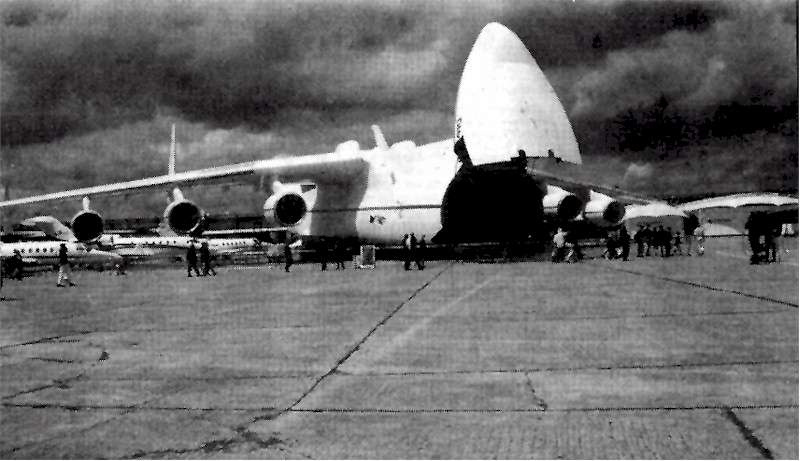
The world's largest airplane, the six-engine Antonov 225, on display at the Paris Air Show in 2001
In 1989, it lifted 508,200 kg to a height of 6,500 ft. Only one exists. In contrast, a 747 lifts 405,000 kg; an A380 will lift 540,000 kg.
by Jack Elliott
The Paris Air Show is the Queen Mother of all air shows. It was born in 1909, before anybody else ever conceived of anything like an air show. Aviation was hardly
out of the cradle. You could a1most count the number of airplanes in the world on your fingers. But the 2nd Paris Automobile Show at the Grand Palais, just off the
Champs-Elysees, included an aircraft exhibit.
It is now a weeklong biennial show (it now alternates with one in Farnborough, England). It may not seem possible to be all things to all people, but in the world of aviation
the Paris Air Show is just that. Everything from small, personal, single-engine planes to the biggest aircraft in the world, the six-engine Russian Antonov 225, is on
display. The latest airliners, business aircraft, and fighter aircraft are there, and many of them are put through flight demonstrations daily.
The show generates more news than any other aviation event. Billions of dollars in sales are booked.
A perennial headline story is the major battle between the two giants of the airliner manufacturing industry, Boeing Aircraft, and Airbus Industries. It reaches fever
pitch there. The two companies are placing major resources behind their contrasting concepts of where air transportation is going. Airbus is putting its money on bigger
aircraft. Its entry is the 555-passenger A380, a double-decker that is larger than the Boeing 747, today's largest airliner.
A few statistics give an idea of the size and scope of this world-class show: 43 countries are represented, 242 aircraft on static exhibit, and more than 270,000 visitors pass
through the gates. More than 3,000 journalists from all over the world cover the event.
Source: The Sunday Star-Ledger 1 July 2001 photo credit Jack Elliott

Really Big Ideas
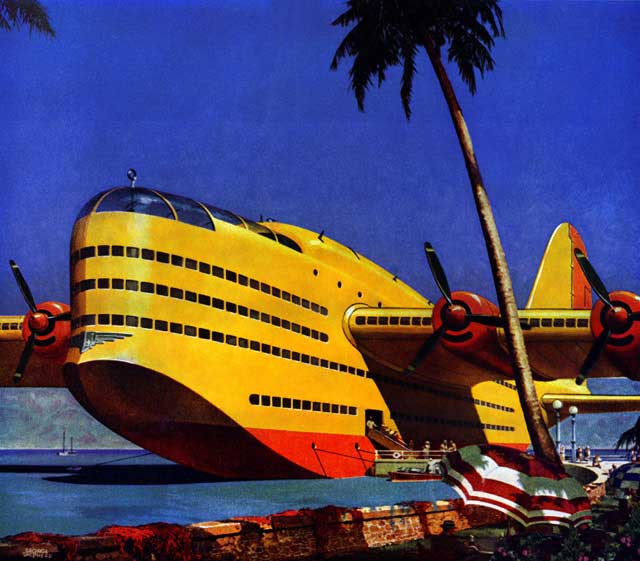
Industry moves on Timken Roller Bearings (1946) | George Shepherd
Source: ephemeranow.com

Airbus Challenges Boeing
I may be expediting the attainment of an object that will in time be found of great importance to mankind, so much so that a new era in society will commence from the
moment that aerial navigation is familiarly realised... I feel perfectly confident, that this noble art will soon be brought home to man's convenience, and that we shall be able to
transport ourselves and our families, and their goods and chattels, more securely by air than by water, and with a velocity of from 20 to 100 miles per hour.
- Sir George Cayley, 1809
Airbus surprised everyone by announcing that they were going to build an A350 plane to challenge Boeing's apparently-quite-successful 200-seat 7E7 Dreamliner. Is that a
good sign for Boeing or a bad sign?
Some seem to think it proves Airbus is worried. They don't think Airbus can really afford to build such a plane at the same time as they are developing
the A380 (which has already cost them more than $10 billion), but they want to disrupt orders from customers for the 7E7. This seems to be standard
operating procedure in the industry to do underhanded things like that - it seems Boeing said they were going to make a stretch 747 as a diversion from
Airbus' new A380. Then they said they would build a Sonic Cruiser to fly at near the speed of sound. But those plans got dropped.
Airbus bet that the market would be for huge planes, while Boeing thought saving fuel would be the main idea. Now, Airbus wants to cover all bases. But getting
financing would mean getting loans from European government backers. There is already a hot trade dispute with Boeing over unfair practices. Boeing says Airbus has
received $15 billion in government aid over the past 30 years.
Boeing says they don't see what would surely be an A330 clone (yawn) as much of a threat - it'll use more fuel (it will weigh more plus the 7E7 has
"fuel-sipping" engines), won't fly as far, won't be available as quickly, and won't be as comfortable. But, some say, they are desperate. The A380
isn't selling as well as they had planned - some airlines opted for more, smaller, long-range planes instead. And the number of orders for the 7E7
made them wonder if they had jumped aboard the wrong train.
Airbus said they had always planned to build a mid-sized plane. They said their customers had urged them to do it. They say their plane will be
more economical than the 7E7 overall because flight crews will be interchangeable.
Right now, Airbus is selling more planes but Boeing is making more money - but that could change. Both companies unsurprisingly say theirs will be the one to come out on
top.

Airbus and Boeing: America Flies to War
Yet I do seriously and on good grounds affirm it possible to make a flying chariot in which a man may sit and give such a motion unto it as shall convey him
through the air. And this perhaps might be made large enough to carry divers men at the same time, together with food for their viaticum and commodities for traffic. It
is not the bigness of anything in this kind that can hinder its motion, if the motive faculty can be answerable thereunto. We see a great ship swims as well as a small cork,
and an eagle flies in the air as well as a little gnat... 'Tis likely enough that there may be means invented if journeying to the moon; and how happy they shall be that are first
successful in this attempt.
- John Wilkins, A Discourse Concerning a New World and Another Planet, Book 1, 1640
The long-running row over subsidies to Airbus and Boeing has gone to the World Trade Organisation.
The rumbling of a trade war over state aid to Europe's Airbus has been in the air for months. On 6 October, after unsuccessful talks between the European Union and
America, the United States Trade Representative, Robert Zoellick, filed a formal complaint to the World Trade Organisation (WTO) alleging that billions of dollars of "unfair"
subsidies were paid to Airbus. Within an hour, the EU said that it would file a counter-claim over equally large sums of unfair aid going to Airbus's rival, Boeing.
Boeing has been smarting ever since Airbus snatched the lead in the civil jet market last year by delivering more aircraft for the first time. Airbus is
still in front this year, with 224 deliveries to the end of September, compared with Boeing's 218. The Americans' beef is that Airbus, which is 80% owned
by EADS, a European aerospace group, and 20% by BAE Systems, still gets soft loans from the governments of Germany, France, Britain and Spain. This
finance comes in the form of repayable loans, known as launch aid, for the development of new aircraft. Some $3.7 billion of it enabled Airbus to
launch its new A380 super-jumbo, which will eclipse Boeing's venerable 747 when it enters service in 2006. Boeing complains, quite reasonably, that
nowadays Airbus is a profitable, successful company and as such should no longer receive this help.
An earlier trade row was settled in 1992 with a bilateral agreement that limited Airbus's launch aid to 33% of the development costs of a new plane,
while indirect support to Boeing (from the Pentagon and NASA) was restricted to 4% of its turnover. Now Boeing and the American government want to replace
that deal with a new agreement that bans all state aid. Boeing's chief executive, Harry Stonecipher, has been itching to have a go at Airbus. He
was brought out of retirement at the end of last year to run the company after it lost its two top executives in a row about improper dealings with the
Pentagon over defence contracts. Previously, as number two at Boeing, he was always pushing for a more aggressive line against Airbus subsidies.
But there is more to it than that. First, the Bush administration is being attacked for the loss of manufacturing jobs, and Boeing's home base for
its civil jets is around Seattle in Washington state, a key battleground in next month's presidential election. And Airbus is likely to come up with a new aircraft that could
spoil the market for Boeing's latest product, the 250-seater 7E7. The Europeans plan to unveil such a rival, dubbed the A350 for now, before the end of the year.
According to Boeing, Airbus can only make such rapid moves in the marketplace because it can count on launch aid. Mr Stonecipher points out that the
European company has been able to roll out 5 new products in the past decade, while Boeing, with an eye to shareholders and its bottom line, has managed one.
It is true that the big attraction of state-provided launch aid is that if a product flops, the money does not have to be repaid; so the risk is borne partly
by European taxpayers. But Airbus now has to continue paying royalties long after the loan and interest have been repaid. Nor is it clear whether
Airbus will ask for launch aid for its new plane, since it is basically a new version of an existing wide-body model, the A330-200.
The odd thing about the timing is that Boeing's newly aggressive approach emerged only after it was revealed that it had learned a trick or two from
Airbus about landing subsidies. It persuaded the state of Washington to provide a tax break worth, according to the State University of New York,
Buffalo, $3.2 billion. This was in return for doing the final assembly of the new 7E7 in its home state. It hawked the project around alternative
sites and Kansas came up with an interest-free bond worth $200 million to fabricate noses and cockpits. And the Italian government is putting up a
subsidy worth $590 million for the manufacture of the rear fuselage by its partly owned aerospace firm, Alenia.
But the grandaddy of aid going to Boeing comes from Japan. This emerged last November when Airbus persuaded the EU to investigate a $1.5 billion subsidy
that the Japanese government is, in effect, putting into the 7E7. A consortium of three companies, the heavy industry parts of Fuji, Kawasaki and Mitsubishi, will make the
wings and fuselage wing box for the 7E7. This is the heart of any plane, and the fact that Boeing has decided to outsource it to the Japanese is highly significant.
Boeing has always resisted Japanese requests to get their hands on important aircraft-making technology in return for Japan's airlines buying from Boeing. But to win a big
launch order for the 7E7 and get financial help, it has had to let the Japanese become key suppliers. All this makes for a tangled web of claim and counter-claim for the WTO
to get to grips with, even before it affects other trade issues.
Source: www.economist.com 7
October 2004

A380 Set to Change the Face of Airports
It's no coincidence that in no known language does the phrase "As pretty as an airport" appear.
- Douglas Adams, The Long Dark Tea-Time of the Soul
In the space age, man will be able to go around the world in two hours -
one hour for flying and one hour to get to the airport.
- Neil McElroy, Look magazine,1958

by Imtiaz Muqbil
Airbus Industrie, manufacturer of the new-generation 550-passenger aircraft, the A380, has begun discussions with 50 major hub airports around the world about the billions of dollars
in infrastructure changes that will have to be made to accommodate the massive aircraft. Wolf Dieter Wissel, the company's director of large aircraft configuration, said the
airports, including Bangkok's, were looking at additional costs of anything from a few million to up to half a billion dollars to upgrade and reconfigure their ground services and
operation systems to ensure smoother turnarounds of the gigantic, double-decker airliner.
Mr Wissel made the comments at the annual conference of the International Flight Catering Association and International Flight Services Association last week in Bangkok. The
event brought together about 200 senior executives in the multi-billion-dollar business of feeding global airline passengers.
In the United States alone, airlines spent about US$2 billion last year on catering and related services. The biggest carrier, American Airlines, alone spent about $680
million. Add to that the millions that have to be spent on cutlery, kitchen equipment, waste-management systems and many more aspects of the food-supply chain, and it becomes big
business indeed.
The dawn of aircraft such as the A380 is today posing in-flight caterers with challenges of a degree comparable to 30 years ago, when aircraft designs shifted from the narrow-body,
150-passenger Boeing 707s to the wide-body 300-plus-passenger 747s. Mr Wissel pointed out that on the A380, anything from 80 to 90 food-tray trolleys will have to be unloaded and
loaded within the span of a 90-minute stopover. This logistical challenge will need to be met without compromising health and safety requirements, as well as meeting the many
specific requirements of passengers, such as kosher and halal food.
A further consideration is having to serve so many meals on long flights that can last anything from 12 to 15 hours. Because people simply cannot be fed too often, airlines are
looking at creating self-service centres where passengers can just help themselves rather than having to be served. At the same time, the aircraft has to carry enough onboard
equipment to ensure that the food remains well-stored, and can be heated or refrigerated as required. All this means that a 550-ton aircraft becomes heavier, which means it has to
carry more fuel to cover the distance, which means higher costs.
That does not even begin to address the environmental issue of waste management and the need to separate garbage for quick disposal after landing.
So far, Airbus has received orders for 32 firm deliveries and 20 options for the A380 from carriers including Singapore Airlines, Emirates, Virgin Atlantic and Air France. Qantas has
sent a letter of intent. The first scheduled flight is expected in mid-2004.
Mr Wissel said one main reason why the aircraft was being introduced in the first place was to reduce congestion in the skies and on the ground. Instead of having several small
aircraft jamming up the runways and plying the skies, all of which need to operate under the same safety requirements, the idea was to have one aircraft that would do the job and bring
people over long distances to hub airports, from which smaller aircraft could carry them to secondary destinations.
While safety remains the priority, the challenge now is to get those millions of future passengers through the immigration and check-in counters and reduce congestion at other spots
like baggage carousels. Managing their in-flight requirements is also taking some doing, in terms of service, entertainment and simple things such as extra space to stretch the
legs on those long flights.
It is an issue that will clearly confront authorities at Bangkok airport. While SIA, which has placed firm orders for 10 A380s, has begun to ensure that Changi airport can
handle them, the delays in development of the second Bangkok airport will mean that Thailand gets left further behind in the race, and faces higher costs, too. Indeed, cost is a
major consideration. Several speakers at the conference mentioned that the regional economic crisis and the depreciation of several currencies had affected air travel. Fewer
passengers meant fewer meal requirements and thus declining revenue, triggering the all-too-familiar call to pare costs.
One response has been to start hiving off and partially privatising airline catering units, as SIA has done and Thai Airways International plans to do, if the unions allow
it. Thai's catering unit handles about 35,000 meals a day in Bangkok alone, and plans to boost the total with the addition of a 4,000 square metre facility to be ready by the end
of 2001. While the Thai flight kitchen handles meals for itself and about 40 other airlines, the other 40-odd airlines operating to Bangkok are served by two other catering
companies: LSG Sky Chefs, an offshoot of Germany's Lufthansa, and Gate Gourmet.
A survey of expansion investments planned by these companies to take advantage of recovering economies and travel, published in the trade publication PAX International,
indicated that Gate Gourmet was developing a special kitchen just for halal food to cater to the growing legions of Muslim travellers. In turn, LSG Sky Chefs is to forge
ahead with a number of joint-venture operations in Asia.
The Bangkok conference also highlighted the likelihood of more business for suppliers of Thai agricultural products because of the popularity of Thai food worldwide, and growing
recognition of its nutritional qualities.
Source: Bangkok Post 23 October 2000 business@bangkokpost.net; photo credit Associated Press

Friendly Skies

by Karen Olsen
Rethinking airports from the ground up will improve both the environment and air travel.
We all know the airline industry is in trouble. Politicians are handing carriers big subsidies to stay in the air. Meanwhile, on the ground, grassroots organizations are
speaking up about environmental and health problems caused by our over-reliance on air travel, from the sprawl that it imposes on a community to the pollution and noise created by
overhead aircraft. Neighbourhood activists in many cities point to increased rates of cancer and asthma in adults, and higher levels of blood pressure and stress hormones in
children who live under airport flight paths.
Jim Starry, an environmental designer in Oakland, California, thinks many of these problems stem from one major flaw: the design of airports. He has conceived a new kind of
airport he believes would solve those problems. He calls it the StarPort. The concept is relatively simple. Planes land on an inclined runway, so they bum less fuel to
slow down, and take off on a declined runway, saving even more fuel. They park above an underground terminal, where rising heat means no need for de-icing (about 50 million gallons
of de-icer pollute water supplies near cold-weather airports each year). Flying in and out of the StarPort, he figures a typical Boeing 747 would save about 1,000 gallons per
flight. And StarPorts can be built closer to cities because they require only 15 to 25 square miles of unpopulated land, as opposed to the 50 square miles or more needed for
traditional airport designs.
"Jim Starry isn't just talking about a new kind of runway," Ed Ayres wrote in the environmental magazine World Watch (July/August 2001). "To him, the whole mindset that
has created the modern major-hub airport doesn't make sense. It's a mind-set based on an almost never questioned assumption - that the solution to rapidly increasing demand for air
travel is to provide an ever-increasing supply of land, fuel, and air space. As a result, in its total impact on climate, ecology, and health, today's mega-airport may be one of
the most ill-conceived forms of large-scale infrastructure humankind has ever devised."
Before 9/11, the StarPort concept was gaining public momentum and the attention of the media. Then came the terrorist attacks, and focus shifted to the airlines' economic
woes. Now the time seems ripe to look at how air travel can be improved as a whole, rather than just bailing out the airlines.
Around the world, we're about to see an airport building boom. China will have built 29 new airports by 2005. Twenty new airports are currently slated for Mexico's Baja
Peninsula. In the United States, 2,000 airports have expansions or additions in the works. If those airports became StarPorts, Starry calculates the fuel savings would
amount to 2 billion gallons a day, enough to end our dependence on Middle East oil.
For much more information on this important topic, visit www.sdearthtimes.com
Source: Utne Reader May/June 2003

Beijing International Airport, Beijing
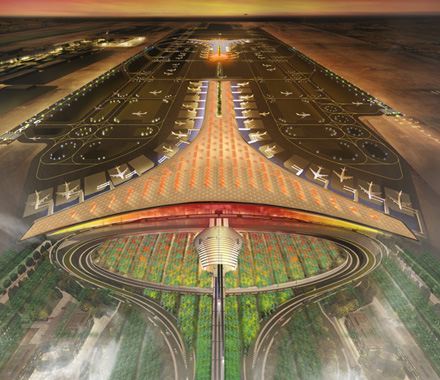
Foster & Partners. Under construction, to be completed in late 2007
According to the US Embassy to China, the country will be building 108 new airports between 2004 and 2009 - including what will be the
world's largest: the Beijing International Airport, designed by Foster & Partners. Set to open at the end of 2007, in time for the Beijing Olympics
in 2008, the airport terminal will cover more than 1 million square metres, giving it a bigger footprint than the Pentagon.
It's designed to handle 43 million passengers a year initially and 55 million by 2015, figures that will probably push the new facility into
the ranks of the top 10 busiest airports, going by the 2004 numbers from the Airports Council International. Given the scale and traffic, Foster & Partners
focused on the traveller's experience, making sure that walking distances are short, for instance.
Building on Foster's experience designing Hong Kong's new mega-airport, the massive Chek Lap Kok, the sprawling Beijing terminal is housed
under a single roof. To help passengers distinguish between different sections of the vast space, skylights cast different shades of yellow and red
light across walls - a subtle but innovative navigational aid. The architects also kept sustainability in mind: An environmental-control system
reduces carbon emissions, and skylights situated on a southeast axis lessen solar heat, keeping the building cool.
Source: images.businessweek.com

I don't care what anybody says - oil will last forever and it will get cheaper and cheaper so that we all can fly anytime, anywhere.

To view other articles related to flying including history, unusual flying machines, hot air balloons, skydiving, gliding, problems, airports, turbulence, pilots, crashes, the
Paris Air Show, the future, blimps, space travel, solar sails and more, clicking the "Up" button below takes you to the Table of Contents for this section on Flight.
|